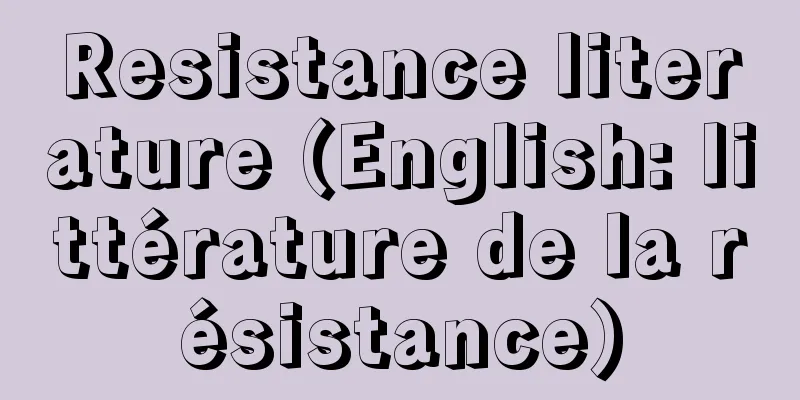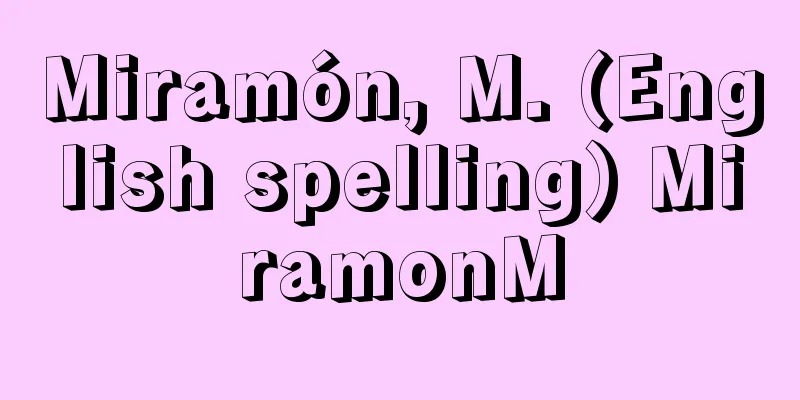Resistance literature (English: littérature de la résistance)

|
The resistance movement of writers and the literature that emerged in France under German occupation (June 1940 to August 1944) during World War II are collectively called "resistance literature." In a broader sense, the literature of Eastern European countries under German occupation and the "anti-Japanese literature" of China and Korea under Japanese occupation could also be called "resistance literature." First, let us take a broad look at the overall situation of French literature under the German occupation. First, there were writers who actively cooperated with the German army, such as Drieu La Rochelle, Brasiac, Céline, and Lucien Rebatet (1903-72). Second, there were writers who supported the Vichy government, such as Henri Massis, René Benjamin (1885-1948), and Abel Bonnard (1883-1968). Third, there were many writers who participated in the Resistance movement in France, such as Aragon, Éluard, Jean Bruller (who later took the name Belcor), Elsa Triollet, F. Mauriac, and Paulhan. Fourth, there were writers who supported the Resistance movement overseas, such as Bernanos, Saint-Exupéry, and Jules Roman. In addition to those mentioned above, there were other writers who wrote about their experiences in German concentration camps. [Tsutomu Kawakami] The role of resistance literatureResistance literature changed in content in response to the stages of the rise of the Resistance movement in France. In the early days of the occupation, there were quite a few writers who cooperated with Germany, and censorship and suppression of publications were relatively mild. Camus's "The Stranger" (1942), which was acclaimed as the greatest masterpiece in occupied Paris, and Aragon's "Les Angles" (1941) were legally published works. However, after the full occupation by German troops (November 1942), as the anti-Nazi and anti-Vichy struggles intensified, illegal underground publications strengthened their role of calling people to fight, inspiring courage, and bearing witness to the fight and the victims. Thus, in the national movement and struggle of the Resistance, literature and literary activity naturally increased their importance, and the social meaning of literature became greater than ever before. [Tsutomu Kawakami] Newspapers and magazinesOne of the early resistance movements, which also included literary figures, was the Groupe du Musée de l'Homme, which had already issued leaflets opposing the German occupation in the autumn of 1940, and published the newspaper Résistance, edited by Claude Aveline (1901-92) and Jean Cassou (1897-1986). After the arrest of Jacques Decour (1910-42) and Georges Politzer (1903-42) and the arrest of other journalists made it impossible to publish the Resistance magazine Pensée libre (Free Thought) (February 1941), Pierre de Lescure (1891-1963), Belcors and others began planning the Midnight Series. Meanwhile, Paulhan, Jacques Debû-Bridel (1902-93) and others founded the CNE (National Committee of Writers), and began publishing its journal, Les Lettres françaises , in September 1942. In Switzerland, Albert Beguin and others published the Cahiers du Rhône series in 1942. Newspapers and magazines were the most important tools of propaganda, including Liberation by Christian Pineau (1904-95), Poésies 40 by Pierre Seghers (1906-87), Confluence by René Tavernier (1915-89), Fontaine by Max-Pol Fouchet (1913-80), and L'Arche by Jean Amrouche (1906-62), both published in Algiers. [Tsutomu Kawakami] Poetry, novels, etc.Poetry, with its directness and conciseness of images and cries, was able to express people's suffering and hopes succinctly, making them universal. Therefore, poetry played the greatest role in resistance literature. As early as April 1941, Aragon published "Poems of a Painful Heart," singing of the sorrows of the occupation, followed by "Elsa's Eyes" (1942) and "The Trumpet of France" (1945). Many resistance poems appeared, including Éluard's "Poetry and Truth" (1942) and "In a German Garrison" (1944), Pierre Emmanuel's "The Tomb of Orpheus" (1941) and "Fighting with Thy Guardian" (1942), and Jean Cassou's "33 Sonnets Written in a Cell" (1943). Because of the illegal publishing during the occupation, it was more difficult to print novels than poetry. Belcors's The Silence of the Sea (1942) took more than six months from completion to publication. Therefore, there were fewer works than poems, and most of them were short stories. Other representative novels include Triolet's The Amours of Avignon (1943), Belcors's Walk to the Stars (1943), Aveline's Hour of Death (1944), and Claude Morgan's (1898-1980) The Sign of Man (1944). Essays include Mauriac's Black Notebook (1943), Aragon's Crimes against the Mind (1942), Bernanos's France against the Robots (1942), and Saint-Exupery's Letter to a Hostage (1943). Plays such as Anouilh's Antigone (1942) and Sartre's The Flies (1943) were mainly performed in Paris, but opinion is divided as to whether works permitted by the occupying forces can be counted as resistance literature. [Tsutomu Kawakami] "The Resisting Intelligence" by Obase Takuzo (1951, Sanichi Shobo)" ▽ "Those Who Believed in God and Those Who Didn't Believe in God" by Watanabe Jun (1951, Nauka Publishing)" ▽ "Literature of Resistance" by Kato Shuichi (included in Kato Shuichi Collected Works Volume 2, 1979, Heibonsha)" ▽ "Resistance and Poets" by Oshima Hiromitsu (1981, Shiraishi Shoten)" ▽ "Parisian Intellectuals under Occupation: Records of Anti-Nazi Censor Heller" by Gerhard Heller, translated by Okubo Toshihiko (1983, Hakusuisha)" ▽ "A Journey to the Vercors" by Kawakami Tsutomu (1994, Showado) [References] | | | | | | | | | | | | | | | | | | | | | | | | |Source: Shogakukan Encyclopedia Nipponica About Encyclopedia Nipponica Information | Legend |
|
第二次世界大戦中、ドイツ軍占領下(1940.6~1944.8)のフランスで展開された文学者の抵抗運動およびその文学を総称して「レジスタンス文学」という。より広義には、ドイツ軍占領下の東欧諸国の文学や、日本軍支配下の中国や朝鮮の「抗日文学」も「レジスタンス文学」ということができよう。 まずドイツ軍占領下におけるフランス文学の全体的状況を俯瞰(ふかん)しておくと、第一に、ドイツ軍に積極的に協力した文学者たち、たとえばドリュ・ラ・ロシェル、ブラジアック、セリーヌ、リュシアン・ルバテLucien Rebatet(1903―72)などがいる。第二に、ビシー政府に加担した文学者たち、アンリ・マシス、ルネ・バンジャマンRené Benjamin(1885―1948)、アベル・ボナールAbel Bonnard(1883―1968)など。第三に、フランス国内でレジスタンス運動に参加した、アラゴン、エリュアール、ジャン・ブリュレール(のちにベルコールと名のる)、エルザ・トリオレ、F・モーリヤック、ポーランなど多くの文学者たち。第四に、海外にあってレジスタンス運動を支援した、ベルナノス、サン・テグジュペリ、ジュール・ロマンなどの文学者たちである。上記のほかに、ドイツの強制収容所での体験をつづった文学者も存在する。 [川上 勉] レジスタンス文学の役割レジスタンス文学は、フランスにおけるレジスタンス運動の高まりの段階に対応して、その内容にも変化がみられる。占領初期はドイツと協調的な文学者も少なからず見受けられたり、また出版物の検閲や弾圧も比較的緩やかであったりした。占領下のパリで最高傑作だと評判になったカミュの『異邦人』(1942)や、アラゴンの『断腸詩集』(1941)などは合法的に出版された作品であった。しかし、ドイツ軍による全面占領(1942.11)以降、しだいに反ナチス、反ビシー闘争が激しくなってくると、非合法の地下出版によって、人々に闘いを呼びかけ、勇気を鼓舞し、そして闘いや犠牲者の証言ともなるという役割を強めた。こうして、レジスタンスという国民的な運動と闘いのなかで、文学ないし文筆活動はおのずからその役割の比重を高めていき、文学がもつ社会的な意味もそれまで以上に大きくなっていったのである。 [川上 勉] 新聞・雑誌類文学者も参加した初期のレジスタンス運動に「人類博物館グループ」Groupe du Musée de l'Hommeの活動があり、すでに1940年秋にはドイツ軍の占領に反対するビラが出され、クロード・アブリーヌClaude Aveline(1901―92)やジャン・カスーJean Cassou(1897―1986)らの編集によって新聞『レジスタンス』が発行される。また、レジスタンスの雑誌『自由思想』Pensée libreが、ジャック・ドクールJacques Decour(1910―42)やジョルジュ・ポリツェルGeorges Politzer(1903―42)らの逮捕によって発行不可能になったあと(1941.2)、ピエール・ド・レスキュールPierre de Lescure(1891―1963)、ベルコールらによって「深夜双書」の計画が進められる。一方、ポーランやジャック・ドビュ・ブリデルJacques Debû- Bridel(1902―93)らによって、CNE(全国作家委員会)が結成され、その機関誌『レ・レットル・フランセーズ』Les Lettres françaisesが42年9月から発刊される。スイスではアルベール・ベガンらによって『カイエ・デュ・ローヌ双書』が42年に発刊されている。新聞や雑誌はもっとも重要な宣伝の道具であり、クリスチアン・ピノーChristian Pineau(1904―95)の『リベラシオン』、ピエール・セゲルスPierre Seghers(1906―87)の『ポエジー40』、ルネ・タベルニエRené Tavernier(1915―89)の『コンフリュアンス』、アルジェで発行されたマックス・ポル・フーシェMax-Pol Fouchet(1913―80)の『フォンテーヌ』、ジャン・アンルーシュJean Amrouche(1906―62)の『ラルシュ』などがあった。 [川上 勉] 詩・小説など詩はそのイメージや叫びの直截(ちょくせつ)性と簡潔性によって、人々の苦しみや希望を端的に表現し、それを万人共通のものにすることができた。したがって、レジスタンス文学のなかで詩の果たした役割はもっとも大きかった。アラゴンは早くも1941年4月には『断腸詩集』を刊行して占領下の悲しみを歌い、続いて『エルザの瞳(ひとみ)』(1942)、『フランスの起床ラッパ』(1945)などを発表する。エリュアールの『詩と真実』(1942)や『ドイツ軍駐屯地で』(1944)、ピエール・エマニュエルの『オルフェの墓』(1941)や『汝(なんじ)の守護者とともに戦う』(1942)、ジャン・カスーの『独房でつづられた33のソネット』(1943)などのほか数多くのレジスタンス詩が登場した。 占領下の非合法出版であるがゆえに、小説の場合には詩以上に印刷が困難であった。ベルコールの『海の沈黙』(1942)は書き上げてから出版までに半年以上もかかっている。したがって詩に比べて作品の数も少ないし、そのほとんどは短編であった。そのほか代表的な小説作品には、「深夜双書」に収められたトリオレの『アビニョンの恋人たち』(1943)、ベルコールの『星への歩み』(1943)、アブリーヌの『死の時』(1944)、クロード・モルガンClaude Morgan(1898―1980)の『人間のしるし』(1944)などがある。エッセイとしては、モーリヤックの『黒い手帳』(1943)、アラゴンの『精神に対する犯罪』(1942)、ベルナノスの『ロボットに対するフランス』(1942)、サン・テグジュペリの『ある人質への手紙』(1943)などがあげられる。 戯曲は、アヌイの『アンチゴーヌ』(1942)やサルトルの『蠅(はえ)』(1943)などが主としてパリで上演されたが、占領軍が許可したものをレジスタンス文学のなかに含めることができるかどうか意見の分かれるところであろう。 [川上 勉] 『小場瀬卓三著『抵抗する知性』(1951・三一書房)』▽『渡辺淳著『神を信じていた者も神を信じていなかった者も』(1951・ナウカ社)』▽『加藤周一著『抵抗の文学』(『加藤周一著作集 第2巻』所収・1979・平凡社)』▽『大島博光著『レジスタンスと詩人たち』(1981・白石書店)』▽『ゲルハルト・ヘラー著、大久保敏彦訳『占領下のパリ文化人――反ナチ検閲官ヘラーの記録』(1983・白水社)』▽『川上勉著『ヴェルコールへの旅』(1994・昭和堂)』 [参照項目] | | | | | | | | | | | | | | | | | | | | | | | | |出典 小学館 日本大百科全書(ニッポニカ)日本大百科全書(ニッポニカ)について 情報 | 凡例 |
<<: Resist - Resist (English spelling)
>>: Resistance - Résistance (English spelling) French
Recommend
mystērion (English spelling) mysterion
...One of the basic terms in Christianity. When t...
Weather Resistance Breeding Project
...These scion and seed orchards supply cuttings ...
Management Spring Offensive
...Although the postwar labor movement has develo...
Shrimp tail
...Rice formation occurs when supercooled cloud p...
Shirane Sanzan - Shirane Sanzan
Also written as Shiraneyama. A mountain range in t...
Yoshishige Satake
A military commander from the Sengoku to Azuchi-M...
Allotype
… The only specimen designated by the namer in a ...
Goldstein, Kurt
Born: November 6, 1878 in Katowice, Silesia [Died]...
Opening - Kairitsu
〘 noun 〙① (━suru) To open up; to establish. Kairyu...
species ecology
...However, systematization as a unified science ...
Synchronous meteorological satellite
... Geostationary meteorological satellites were ...
Hula (English spelling)
A folk dance of the Hawaiian Islands. Originally p...
Craftsman - Shikish
During the ceremony, Buddhist chant Bonbai・Scatter...
Ebisudai (English name) Japanese squirrelfish
A marine fish belonging to the order Alfonsinophy...
Pravda - Pravda (English spelling) Правда/Pravda
A daily newspaper published in Moscow and distrib...









